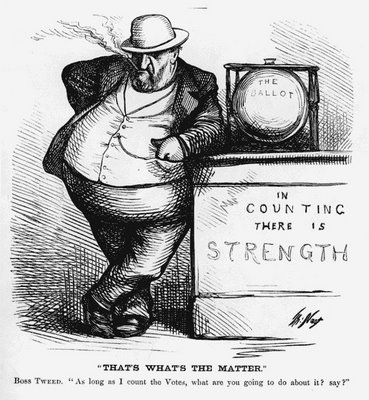Over My Shoulder #45: How Empire comes home in sado-statism and police brutality. From Fred Woodworth, “Evil Empire Notes,” in The Match! # 107 (Summer, 2009)
At the top of the post, make a list of the books you’ve read all or part of, in print, over the course of the past week, at least as far as you can remember them. (These should be books that you’ve actually read as a part of your normal life, and not just something that you picked up to
read
a page of just in order to be able to post your favorite quote.)Pick one of those books from the list, and pick out a quote of one or more paragraphs, to post underneath the list.
Avoid commentary above and beyond a couple sentences, which should be more a matter of context-setting or a sort of caption for the text than they are a matter of discussing the material.
Quoting a passage absolutely does not entail endorsement of what's said in it. You may agree or you may not. Whether you do isn't really the point of the exercise anyway.
Here’s the books:
- Sonia Johnson (1989). Wildfire: Igniting the She/Volution. (Albuquerque: Wildfire Books. I picked it up some time ago through BookMooch.)
- Richard Gombin (1975), The Origins of Modern Leftism. Translated from the French by Michael K. Perl. (Baltimore: Penguin. Picked up this very week for 49¢ from the Shaman Drum used books sale rack!)
- Fred Woodworth, The Match! Issue No. 107 (Summer, 2009). (Tucson: Fred Woodworth. PO Box 3012, Tucson, Arizona 85702. I picked my copy up last week from May Day Books in Minneapolis.)
And here’s the quote. This is taken from Fred Woodworth’s Evil Empire Notes, Issue No. 107 of The Match! (Summer 2009; also, incidentally, the 40th anniversary issue of The Match!). This was airplane reading, taken in somewhere in the sky between Minneapolis and Las Vegas.
GIVEN all the millions of horrifying stories in the naked country, now and then it’s good to pluck out one to hear an authentic voice rather than a statistic. Amnesty International printed up this one, by Donald Boyd of Chicago:
I have been a victim of racial profiling since I was 17 years old. Once when I was walking to the cleaners, I stopped to talk with some young men…. When I walked away, the police just automatically accused me of purchasing drugs. Two officers jumped out of a car and kept asking
What did they sell you?I repeatedly replied no one sold me anything. … They cuffed me and drove me to a police substation.… The next morning they loaded 45 people into a van made for 32. The men were almost all black and Latino. When we arrived at the jail, sheriff’s deputies, dressed in riot gear, met us. They shouted obscenities and threats. The deputies assaulted several people, including me, for supposedly not complying with their every word.
At each step in the process–arrest, detention and bond hearing–we were lined up, and numbers were scribbled on our arms with black marking pens…. In court, you appear before a judge, but via a television screen. You don’t get to speak, and the judge never even looks you in the face…. They treat our communities with disdain and contempt. I had to hire a lawyer and spend thousands of dollars to get the charges dismissed….
AS
Lawbecomes increasingly complex, with hundreds of thousands and even millions of laws stacked on top of each other, almost no one can confront officialdom in any way without a lawyer. But what happens when your lawyer takes your money and does no work, don’t file basic motions or writs, and essentially shafts you? Not much. Bar associations have a cap of compensatory payments they sometimes make to incompetent or dishonest lawyers’ clients, but the amouts are often based on century-old, or even older, stated maximums. And it’s next to impossible to go after such a lawyer legally, because to do so you need… another lawyer.
. . .
EIGHT COPS raided a home in Minneapolis in ’08. They shot up the place, accidentally not killing anyone. Well, it was the
wronghouse (there is norighthouse for something like this). This is completely comparable to a surgeon amputating the wrong leg, but if the doctor who did this to you then got a commendation from the medical association, wouldn’t you feel absolutely floored? So did the family whose home was raided and shot up. All eight cops received medals.Undoubtedly this sounds like hyperbole or mere rhetoric, but the simple fact is that there is no conceivable way anyone can interpret this but as an official statement of
Good Work, Mento stupid, negligent, incompetent thugs for terrorizing and injuring innocent people.
NOT SURPRISINGLY, when humanitarian spirit is dead in officialdom it’s not partly alive; it really is extinct and defunct. Also in Minnesota, a poor wild bear somehow got a plstic jar or bucket stuck on its head. Official solution: shoot the bear. No sympathy for an unfortunate creature; no imaginative or bold remedy. Just kill.
AS REPORTED by the Washington Post, prison guards at Prince George’s County Jail in Maryland are apt to be the kind of guys the average person expects to hear of as BEHIND bars. An investigation by the paper found guards who’ve been charged with assault, theft, beating and threatening their wives with death, having sex with prisoners, robbery at gunpoint, and other crimes.
Among the nine officers was Mark R. Bradley, whose then-wife asked for a protective order in 1998, claiming he had threatened, taunted, punched and slapped her… When she reached for the phone, Bradley who had been on the force for almost four years, yanked it away… His wife recalled him saying:
Call the police… Make me lose my job. I’ll kill you.Almost a decade later, he was still on the payroll at the jail, despite three protective orders issued against him in the late 1990s. In 2004, he pleaded guilty to assaulting another woman, whose rib was broken. The woman, who had been pregnant with his child, told police that after a beating days earlier, she had a miscarriage. A judge put Bradley on probation and ordered him to take an anger management class.
AIRPORT FASCISM is being extended to railroads. Amtrak, the railroad passenger company, has brought in a SWAT-style phalanx of agents in full combat gear to sweep through train stations, randomly
screeningand searching passengers. Therandomlychosen passengers will have to place their bags on a platform and be swabbed with chemicals that are claimed to react to traces of explosives. You can also be ratted out by dogs.
ONE OF THE factors that propelled the United States as far along into the police state that it now is, was the Vietnam War. There’s plenty of evidence that soldiers in ALL wars become brutalized, but something extraordinary seems to have taken place in Vietnam. Whatever it was, American men who went there (and survived) tended to come back in a vicious state of mind. Ordinary people were their enemy. They made up stories (essentially none has ever been verified) of people spitting on them when they arrived at stateside airports; and they formed cliques of us-versus-them. Looking for work, a high proportion of them went into law enforcement, and there they reinforced and amplified the already-existing us versus them mentality, ratcheting the propensity toward police brutality to amazing heights.
Now the same thing is happening with Iraq. Our guess is that the psychological corruption happens when soldiers fight amid a culture and a language that has few points of contact with the west and with Indo-European languages. It is one thing to fight, say, Germans or Italians, whose general culture is largely familiar (same religions, for instance) and whose languages have a large percentage of words that are the same or nearly enough so to be comprehensible even to the monolingual standard American youth. But in Vietnam–and now in Iraq–these military people are surrounded by words and behaviors utterly alien to them. Our own idle theory, therefore, is that this operate on their minds in such a way that the enemy becomes completely dehumanized. This creates the us-versus-them, and when they return to the USA, they still have it.
Then they go into law enforcement.
Already we are beginning to read about cases in which police–now Iraq war veterans–are opening fire on people merely running away from them. And already, too, the convoluted excuses are starting to evolve:
Re-experiencing a war zone is one of several classic signs of combat stress reaction,says the Department of Veterans Affairs. If persistent and untreated, the Department goes on, this can result inpost traumatic stress disorder.Whatever verbal gimmickery you haul out to gloss over the facts, the truth is that these men (generally they are men) have been ruined, corrupted fatally and irretrievably, by being sent out to murder masses of people for no good reason in a country where they ought never to have gone. Mostly it’s their own fault, too, since ultimately it was their own volition that was compliant in their going there.
The bottom line is that Bush’s freudian effort to surpass his father’s Panama coup by similarly taking Saddam Hussein, unresisted by the press and the American people at the outset, is now going to result in thirty or forty more years of ever-worsening police violence against the public here. With this on top of everything else–the overpopulation, insanely burgeoning law-pollution, disastrous shift to digital culture, etc.–America is rapidly turning into an unliveable hell. Then add global warming.
IMMIGRATION PRISONS, where you’re sent for not having adequate proof of being a so-called citizen, are the new concentration camps of the Evil Empire. There are now a whole class of persons of various ethnicities who are afraid to travel outside of the towns or cities where they live, because of the possibility of being stopped by some profiling trick excused as a broken taillight, and then being sent sprawling into a cell at an immigration prison.
A recent well-publicized case in some of the larger newspapers (and excluded from the local dailies) concerned one Hiu Lui Ng, who’d come to the US from Hong Kong. Making the mistake of going to immigraiton headquarters in New York City to get a
green card(legal authorization to live and work in this country), he was grabbed and put behind bars. There he developed cancer, was in severe pain, laughed at by themedicalmatrons, and eventually died from the rampaging and untreated disease.. . .
They denied him a wheelchair and refused pleas for an independent medical evaluation. Instead, … guards at the Donald W. Wyatt Detention Facility in Central Falls, Rhode Island, dragged him from his bed on July 30, craried him in shackles to a car, bruising his arms and legs, and drove him two hours to a federal lock-up in Hartford, where an immigration officer pressured him to withdraw all pending appeals of his case.(New York Times.)One out of hundreds of thousands.
–Fred Woodworth, Evil Empire Notes, in The Match! Issue No. 107 (Summer, 2009). 19–21.

